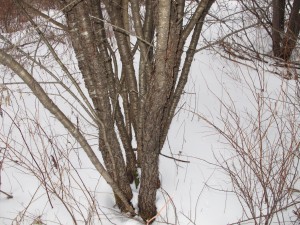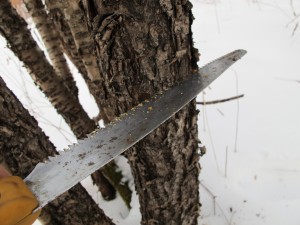Getting Rid of Invasives
Posted on Tuesday, January 21, 2020 · Leave a Comment
My mother used to say, “The road to hades is paved with good intentions.” That is particularly true for gardeners and plant collectors. Most of those nasty invasive plants we struggle to eliminate from our landscape were brought here from abroad by people who didn’t know better. They thought the plants would be a useful addition to their landscape. Plants such as barberry, Japanese knotweed and burning bush looked great to them. What they didn’t bring, of course, were the insects that eat them and keep their numbers under control in their native environments.
January is down time in the garden, generally. We can’t plant anything, and often the snow is deep. But if the January thaw has melted away the snow and ice where you are, this is a time when you could work on getting rid of some invasive trees and shrubs.
Actually, what I have I mind is helping to reduce the vigor and number of mature plants by cutting them down. That won’t kill them, but will keep them from producing seeds next year or even longer. Most invasives have roots that will send up new sprouts, come spring. And winter is not a time when you can dig up or pull out roots. But cutting them down and burning them is a chore you can do now.
The first task you have in this effort is to learn to identify the plants. For me, the most common invasive plants in the woods around my home are bush honeysuckle and barberry.
Invasive bush honeysuckle can get to be 10 to 15 feet tall and wide. It has fragrant white blossoms in June and oval-shaped leaves that are opposite each other on small twigs. In winter the bark is distinctive – slightly shaggy with distinctive ridges. If you cut a stem, there is a hollow spot in the center of the stem, though it might only be the diameter of a pencil lead. The shrub produces red or orange berries.
Japanese barberry is a tough plant that I have seen in deep woods, far from homes or roads. In full sun it produces massive quantities of red berries that birds eat and then drop the seeds all over. The bush has small green or purple leaves and is dense with thorns. I visited a barberry hedge recently, and it was still loaded with berries. The best solution? Cut it down now, and dig out the roots in the spring.
Burning bush ( Euonymus a) is on invasive species lists throughout New England, even though I rarely see seedlings in the woods, and have none on my property. It is best identified in the fall, when its scarlet leaves are noticeable. It is more of a problem in Rhode Island, Connecticut and Massachusetts. I once saw a bumper sticker that said, “30 Below Keeps Out the Riff-Raff. I assume it was talking about plants like burning bush which survives here, but doesn’t spread as fast as it does in warmer climes.
Buckthorns are small trees or large shrubs that are very difficult to eliminate. If you cut one down, the root system will send up many, many new shoots, come spring.
There are two different species of buckthorn common in New England: common buckthorn (Rhamnus cathartica) and glossy buckthorn (Rhamnus frangula), a smaller version with pretty shiny leaves. Both produce berries that turn a deep purple and are the size of blueberries, put with a pit in the middle like a cherry.
You can kill these two by double girdling the trunks with a hand saw, cutting through the bark and green cambium layer while avoiding the dense heartwood. By double girdling, I mean cutting two lines all the way around the stem a foot apart or so. If you do it now, the plants will leaf out and grow normally this year, and perhaps even next year, but then they will die – without sending up new shoots. I have done this.
By cutting through the cambium layer, no nutrients will be sent to the roots, and the roots eventually starve. Common buckthorn is often multi-stemmed with stems close together, so getting a saw in around each stem can be difficult.
Why bother with all this? First, although birds may eat the berries of invasive plants and distribute their seeds, they did not evolve with the plants and often do not benefit much from what they eat. The invasives also out-compete many of our own native plants. They leaf out earlier in the spring and drop leaves later in the fall than our natives. They often shade out or disrupt the growth of wild flowers, too.
Invasive trees and shrubs may be less attractive to the caterpillars that feed on our native trees and shrubs, and which are such an important food source for baby birds. Butterflies and moths lay their eggs on the leaves of native woody plants so that their caterpillar babies will eat well. Those caterpillars make up the vast majority of food for nestlings, even those species that develop into seed eaters. So avoid growing invasives.
Take advantage of the January thaw – or a thaw anytime this winter – and remove some invasive plants. Get a burn permit, some marshmallows and do your woods some good. And have fun!
Henry is the author of 4 gardening books. You can email him at henry.homeyer@comcast.net.
Controlling Invasive Woody Plants
Posted on Wednesday, March 13, 2013 · Leave a Comment
We’ve had a few days of spring-like weather and I’m champing at the bit, ready to start gardening as soon as the snow disappears. There’s not too much we can do as yet. One thing I’ve been doing recently is trying to get rid of invasive trees, specifically the common buckthorn. That’s a long process, so it’s a good thing to work on now, before planting season.

Common Buckthorn
Common buckthorn and glossy buckthorn are two species of small trees that arrived here from Europe or Asia, where they are native, and that have found the new world (more than) suitable for their needs. They are understory plants that will grow in sun or shade, wet or dry, good soil or bad. And they are very hard to get rid of. Like many invasives, if you cut down one, many new shoots will sprout up.
I don’t use herbicides, but there is a way to kill buckthorns without using herbicides. Several years ago I was told about “double girdling” them as way to slowly kill them – without generating root sprouts. Now, while they are dormant, is a good time to begin.
Take a pruning saw and cut through the outer bark and the green cambium layer, but do not cut into the hard core of the trunk. Go all the way around the tree, so that you have girdled the tree. Be sure to connect the beginning and end of your cut (which requires that you keep your saw blade level as you cut). Then do it again 12 inches above the initial cut.

Girdling Buckthorn
If you girdle the tree this year, it will leaf out and act as if nothing bad had occurred. Next year, it will leaf out, but may start to show signs of decline. In the third year, the tree will die. And best of all, no root sprouts will pop up. (Or they didn’t for me, anyhow, when I tried it a few years ago).
One problem: common buckthorn’s growth habit is to start off as a single trunk, and then immediately split off into 6-12 smaller trunks. Since I couldn’t double girdle the tree down low, I had to do so on each of the many upward-growing shoots. And another thing: buckthorns commonly have depressions or dimples in their stems. So when cutting through the bark, it is easy to miss a section because your saw can go over a dimple and leave the job incomplete.
Norway maples (Acer platanoides) are on the list of invasive species in most New England states, and also need to be weeded out. They are on the list because they can out-compete our native maples (and other trees) for water, sunlight and nutrients, and because they seed into the woods whenever present. I have not tried the double girdling technique on them because I have none on my property. But if you have some, I suggest you try it – and then please email me in 3 years if the technique works.
‘Crimson King’ is a cultivar of Norway maple that is very attractive, with nice dark purple leaves. It was sold in huge numbers up until recently. It is a hybrid, and the numerous seedlings it produces are mostly green-leaved – which means that most gardeners just assume that the maple seedlings they see in their woods are native maples. There is a way to test a maple to see if it is a Norway. Once summer comes, snap off a leaf and look at the base of the petiole (leaf stem). If it oozes white sap, it’s a Norway maple.
Other trees and shrubs that can be invasive include bush honeysuckle, tree of heaven, barberry , Russian olive, autumn olive, burning bush, border privet, princess tree (Powlownia tomentosa), and multiflora rose. Most share these characteristics: they are tough trees, produce lots of seeds, and will out-compete native species – they have been introduced from abroad.
I recently spoke to Blaine Moore of Maverick Farm in Sharon, VT about a technique he has used on invasives. He cuts them off close to ground level, and then covers the cut stem with a tin can so that no light gets to the stem – light can stimulate cut stems to grow or to send up root sprouts. He told me he has used this technique successfully for a number of years on a variety of types of invasives and he swears by it. I have not tried this yet, but I have lots of honeysuckle, and I will try it this spring – it’s much less work than digging them out. He sometimes uses tuna cans and nails the can onto a stump to keep it in place.
I have written in the past about a nifty tool for pulling young woody invasives, the weed wrench (www.weedwrench.com). This is a very sturdy hand tool that allows you to grab onto a tree or shrub with a self-tightening jaw, and pull them out with the leverage of a steel arm. They come in four sizes and are a good investment for garden clubs. Of course you will have to wait until the soil thaws to start pulling out culprits. Meanwhile, go try some double-girdling.
Henry Homeyer can be reached by email at henry.homeyer@comcast.net. His Web site is www.Gardening-Guy.com.




